 W
WThe Afanasievo culture, or Afanasevo culture, is the earliest known archaeological culture of south Siberia, occupying the Minusinsk Basin and the Altai Mountains during the eneolithic era, c. 3300 to 2500 BCE. It is named after a nearby mountain, Gora Afanasieva in what is now Bogradsky District, Khakassia, Russia.
 W
WThe Andronovo culture is a collection of similar local Bronze Age cultures that flourished c. 2000–900 BC in western Siberia and the central Eurasian Steppe. Some researchers have preferred to term it an archaeological complex or archaeological horizon. The older Sintashta culture, formerly included within the Andronovo culture, is now considered separately within Early Andronovo cultures.
 W
WThe Battle Axe culture, also called Boat Axe culture, is a Chalcolithic culture which flourished in the coastal areas of the south of the Scandinavian Peninsula and southwest Finland, from around 2800 BC to 2300 BC.
 W
WThe Bodrogkeresztúr culture was a middle Copper Age culture which flourished in Hungary from 4000 to 3600 BC.
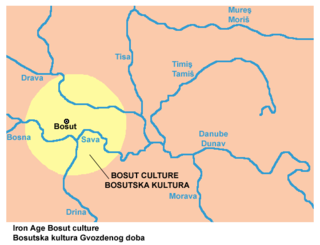 W
WBosut culture is a name of an prehistoric Iron Age culture, which was named after Gradina on Bosut archaeological site in Serbia. It is sometimes grouped with related Basarabi culture into Bosut-Basarabi complex. There are different views about ethnic identity of the people of Bosut culture; according to one view, they were Triballi, while according to another view, they were Daco-Getaes. The culture flourished in the first half of the 1st millennium BC, until the arrival of the Scythian tribes.
 W
WThe Catacomb culture was a Bronze Age culture which flourished on the Pontic steppe in 2800–1700 BC.
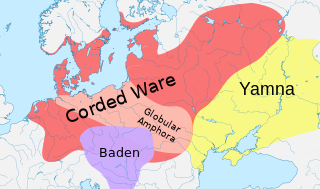 W
WThe Corded Ware culture comprises a broad archaeological horizon of Europe between c. 3100 BCE – circa 2350 BCE, thus from the late Neolithic, through the Copper Age, and ending in the early Bronze Age. Corded Ware culture encompassed a vast area, from the contact zone between the Yamnaya culture and the Corded ware culture in south Central Europe, to the Rhine on the west and the Volga in the east, occupying parts of Northern Europe, Central Europe and Eastern Europe.
 W
WThe Coţofeni culture, generally associated with the Usatovo culture, was an Early Bronze Age archaeological culture that existed between 3500 and 2500 BC in the mid-Danube area of south-eastern Central Europe.
 W
WThe Dnieper–Donets culture was a Mesolithic and later Neolithic culture which flourished north of the Black Sea ca. 5000-4200 BC. It has many parallels with the Samara culture, and was succeeded by the Sredny Stog culture.
 W
WThe Ezero culture, 3300—2700 BC, was a Bronze Age archaeological culture occupying most of present-day Bulgaria. It takes its name from the Tell-settlement of Ezero.
 W
WThe Fatyanovo–Balanovo culture was a Chalcolithic and early Bronze Age culture which flourished in the forests of Russia from c. 2900 to 2050 BC.
 W
WThe Gaudo Culture is an Eneolithic culture from Southern Italy, primarily in the region of Campania, active at the end of the 4th millennium BC, whose typesite necropolis is located near Paestum, not far from the mouth of the river Sele. Its name comes from the Spina-Gaudo necropolis.
 W
WThe Gumelniţa–Karanovo VI culture was a Neolithic culture of the 5th millennium BC, named after the Gumelniţa site on the left (Romanian) bank of the Danube.
 W
WKemi Oba culture, ca. 3700—2200 BC, an archaeological culture at the northwest face of the Sea of Azov, the lower Bug and Dnieper Rivers and the Crimea. The Kemi Oba culture is contemporaneous and partly overlapping with the Catacomb culture.
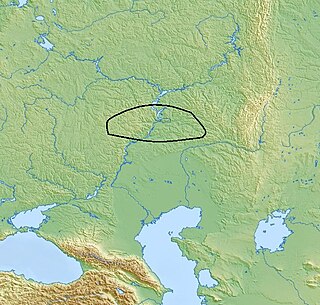 W
WThe Khvalynsk culture was a Middle Copper Age culture of the middle Volga region, discovered at Khvalynsk on the Volga in Saratov Oblast, Russia. It was preceded by the Early Eneolithic Samara culture, from which it came, and succeeded by the Late Eneolithic, Early Yamna culture, into which it developed.
 W
WThe Mikhaylovka culture, Lower Mykhaylivka culture is a Copper Age archaeological culture which flourished on the Pontic steppe from 3600 BC to 3000 BC.
 W
WThe Maykop culture, c. 3700 BC–3000 BC, was a major Bronze Age archaeological culture in the western Caucasus region.
 W
WThe Middle Dnieper culture is a formative early expression of the Corded Ware culture, ca. 3200—2300 BC, of northern Ukraine and Belarus.
 W
WThe Mierzanowice culture appeared in the area of the upper and middle basin of the Vistula, during the Early Bronze Age. It evolved from the so-called Proto-Mierzanowice cultural unit. The name of the culture comes from an eponymous site in Mierzanowice, where the cemetery was located. This entity was part of the pre-carpathian sphere epicorded cultures and it has been divided into three local groups: Samborzecka, Iwanowicka and Pleszowska. The initial phases of the culture are characterized by a small number of burials, seasonal settlements and single artifacts. The area of the Mierzanowice culture spread over from western Slovakia, through south - eastern Poland, reaching in the east the areas of the Volhynian Upland.
 W
WMulti-cordoned Ware culture or Multiroller ceramics culture, translations of the Russian: Культура многоваликовой керамики Kul'tura mnogovalikovoj keramiki (KMK), also known as the Multiple-relief-band ware culture, the Babyno culture and the Mnogovalikovaya kul'tura (MVK), are archaeological names for a Middle Bronze Age culture of Eastern Europe.
 W
WThe Nordic Bronze Age is a period of Scandinavian prehistory from c. 1700–500 BC.
 W
WThe Novodanilovka group, also called the Novodanilovka culture, was a Copper Age culture which flourished along the lower Dnieper and the steppes of Ukraine from c. 4400 BC to 3800 BC.
 W
WNovotitarovskaya culture, also known as the Novotitorovka culture, was a Bronze Age archaeological culture which flourished in the North Caucasus ca. 3300–2700 BC.
 W
WPoltavka culture was an early to middle Bronze Age archaeological culture which flourished on the Volga-Ural steppe and the forest steppe in 2700—2100 BCE.
 W
WThe Qäwrighul culture is a late Bronze Age culture which flourished along the Kongque River in Xinjiang from ca. 2100 BC to 1500 BC.
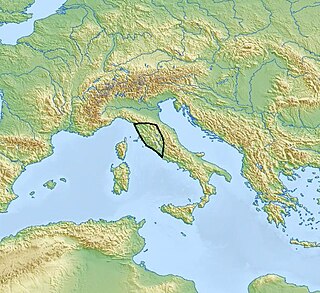 W
WThe Rinaldone culture was an Eneolithic culture that spread between the 4th and the 3rd millennium BC in northern and central Lazio, in southern Tuscany and, to a lesser extent, also in Marche and Umbria. It takes its name from the town of Rinaldone, near Montefiascone in the province of Viterbo, northern Lazio.
 W
WSamara culture is the archaeological term for an eneolithic culture that bloomed around the turn of the 5th millennium BC, located in the Samara bend region of the upper Volga River. The Samara culture is regarded as related to contemporaneous or subsequent prehistoric cultures of the Pontic-Caspian steppe, such as the Khvalynsk, Repin and Yamna cultures. The Proto-Indo-European homeland is often linked to one or more of these cultures.
 W
WThe Single Grave culture was a Chalcolithic culture which flourished on the western North European Plain from ca. 2,800 BC to 2,200 BC. It is characterized by the practice of single burial, the deceased usually being accompanied by a battle-axe, amber beads, and pottery vessels. The Single Grave culture was a local variant of the Corded Ware culture, and appears to have emerged as a result of a migration of peoples from the Pontic-Caspian steppe. It was succeeded by the Bell Beaker culture, which according to the "Dutch model" appears to have been ultimately derived from the Single Grave culture. More recently, the accuracy of this model has been questioned.
 W
WThe Suvorovo culture, also called the Suvorovo group, was a Copper Age culture which flourished on the northwest Pontic steppe and the lower Danube from 4500 BC to 4100 BC.
 W
WThe Trialeti culture, also known as the Trialeti-Vanadzor [Kirovakan] culture, is named after the Trialeti region of Georgia and the city of Vanadzor, Armenia. It is attributed to the late 3rd and early 2nd millennium BC. Trialeti culture emerged in the areas of the preceding Kura-Araxes culture. Some scholars speculate that it was an Indo-European culture.
 W
WThe Tumulus culture dominated Central Europe during the Middle Bronze Age.
 W
WThe Únětice culture is an archaeological culture at the start of the Central European Bronze Age, dated roughly to about 2300–1800 BC. The eponymous site for this culture, the village of Únětice, is located in the central Czech Republic, northwest of Prague. Today, the Únětice culture is known from about 1,400 sites in the Czech Republic and Slovakia, 550 sites in Poland, and, in Germany, about 500 sites and loose finds locations. The Únětice culture is also known from north-eastern Austria, and from western Ukraine.
 W
WThe Vatin culture is a name of an prehistoric Bronze Age culture, which was named after village Vatin in Serbia. The culture had Indo-European roots and was culturally connected with Mycenaean Greece. The Vatin culture is dated to the middle Bronze Age and it is generally divided into three phases: Pančevo-Omoljica, Vatin-Vršac, and Belegiš-Ilandža. It flourished from 16th to 13th century BC.
 W
WThe Vučedol culture flourished between 3000 and 2200 BCE, centered in Syrmia and eastern Slavonia on the right bank of the Danube river, but possibly spreading throughout the Pannonian plain and western Balkans and southward. It was thus contemporary with the Sumer period in Mesopotamia, the Early Dynastic period in Egypt and the earliest settlements of Troy. Some authors regard it as an Indo-European culture.
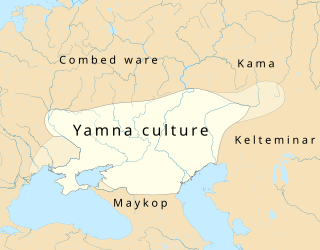 W
WThe Yamnaya culture, also known as the Yamnaya Horizon, Yamna culture, Pit Grave culture or Ochre Grave culture, was a late Copper Age to early Bronze Age archaeological culture of the region between the Southern Bug, Dniester, and Ural rivers, dating to 3300–2600 BC. Its name derives from its characteristic burial tradition: Ямная is a Russian adjective that means 'related to pits (yama)', and these people used to bury their dead in tumuli (kurgans) containing simple pit chambers. "Yamna" is the name that is derived from the same word in Ukrainian.